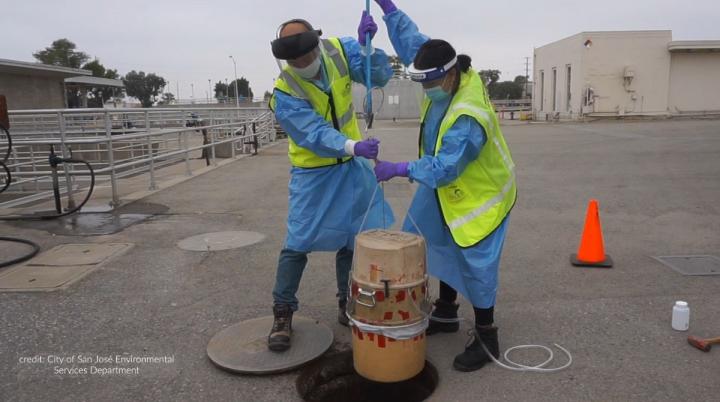Stanford engineers co-lead research designing more responsive COVID-19 wastewater testing

Credit: Image credit: City of San José Environmental Services Department
Accurately identifying changes in community COVID-19 infections through wastewater surveillance is moving closer to reality. A new study, published in Environmental Science & Technology, identifies a method that not only detects the virus in wastewater samples but also tracks whether the infection rates are trending up or down.
Testing wastewater – a robust source of COVID-19 as those infected shed the virus in their stool – could be used for more responsive tracking and supplementing information public health officials rely on when evaluating efforts to contain the virus, such as enhanced public health measures and even vaccines when they become available.
The test works by identifying and measuring genetic material in the form of RNA from SARS-COV-2, the virus that causes COVID-19. “This work confirms that trends in concentrations of SARS-CoV-2 RNA in wastewater tracks with trends of new COVID-19 infections in the community. Wastewater data complements the data from clinical testing and may provide additional insight into COVID-19 infections within communities,” said co-senior author Alexandria Boehm, a Stanford professor of civil and environmental engineering.
As the U.S. grapples with record-breaking daily transmission rates, obtaining more information to track surges and inform public health policies in local communities remains key to managing the deadly virus. COVID-19 can be particularly hard to track, with many asymptomatic or mild cases going undetected. Those who do get tested can still spread the infection before they receive test results, inhibiting quick identification, treatment and isolation to slow the spread. Faster identification of case spikes could allow local officials to act more quickly before the disease reaches a crucial tipping point where transmission becomes difficult to contain and hospitalizations overwhelm the local health system.
Tracking COVID-19 through wastewater surveillance of RNA is gaining steam across the country and could alert decision-makers about potential outbreaks days before individuals recognize symptoms of the virus. The viral RNA can be isolated from sewage in wastewater treatment facilities and identified through a complicated and highly technical recovery process, with the relative amounts in wastewater correlating to the number of cases. Anyone with a toilet connected to a sewer system could be depositing these biological samples on a regular basis, making wastewater sampling an inclusive source of information about COVID-19 in a community.
With this in mind, the researchers sought to advance the effectiveness and accuracy of wastewater surveillance for COVID-19 by comparing the ability to detect the virus in two forms of wastewater – a mostly liquid influent or a settled solid (sediment settled in a tank). Most current research focuses on influent samples; however, the team notes many viruses have an affinity for solids and expected higher concentrations of the virus in these samples, which could improve detection and consistency.
The researchers found the settled solid samples had higher concentrations and better detection of SARS-CoV-2 compared to the liquid versions. “These results confirmed our early thinking that targeting the solids in wastewater would lead to sensitive and reproducible measurements of COVID-19 in a community. This means that we can track upward trends when cases are still relatively low,” said co-senior author Krista Wigginton, an associate professor in civil & environmental engineering from the University of Michigan. Wigginton and Boehm co-lead the research.
The researchers then tested about 100 settled solid samples from the San Jose-Santa Clara Regional Wastewater Facility from mid-March to mid-July 2020, tallying daily concentration numbers. Using statistical modeling they compared these concentrations with COVID-19 confirmed cases provided by the county. Their results tracked the trend of the county’s cases, decreasing in both May and June and peaking in July.
The research presents a possible way to identify new outbreaks, find hotspots, confirm the decrease of cases and inform public health interventions. As schools reopen, the technology could be implemented by districts to identify whether community virus circulation is decreasing. It also has the potential to be used in areas lacking the resources for robust individual clinical testing, such as testing sites in Illinois that reportedly closed early after running out of tests.
There are still pieces of information needed to better understand the limitations of wastewater testing and improve what can be gleaned, the researchers note. The virus’s rate of decay in wastewater, the extent and timeline of viral RNA shedding when sick and varying operations of different wastewater plants all have the potential to impact results. Future studies on these factors could lead to better insights about case trends.
The team is launching a new pilot this month to sample up to eight wastewater treatment plants within California daily, with a 24-hour turnaround time. The pilot aims to better understand what types of almost real-time data are useful to public health officials. Implementing the methods and framework developed by the team and pilot study could also be used in the future to monitor wastewater for pathogens beyond COVID-19 circulating within communities.
###
Boehm is also a senior fellow at the Stanford Woods Institute for the Environment and an affiliate of the Stanford Program on Water, Health & Development. Additional authors are: Katherine Graham, Stephanie Loeb, Marlene Wolfe, Sooyeol Kim, Lorelay Mendoza and Laura Roldan-Hernandez, Stanford Civil & Environmental Engineering; David Catoe, SLAC National Accelerator Laboratory; Nasa Sinnott-Armstrong, Stanford School of Medicine; Kevan Yamahara, Monterey Bay Aquarium Research Institute; Lauren Sassoubre, University of San Francisco, Engineering; County of Santa Clara Public Health Department; Kathryn Langenfeld, University of Michigan, Civil & Environmental Engineering.
Payal Sarkar, Noel Enoki and Casey Fitzgerald from the City of San José Environmental Services Department also contributed to the project.
Media Contact
Michelle Horton
[email protected]




